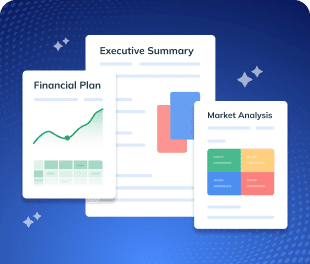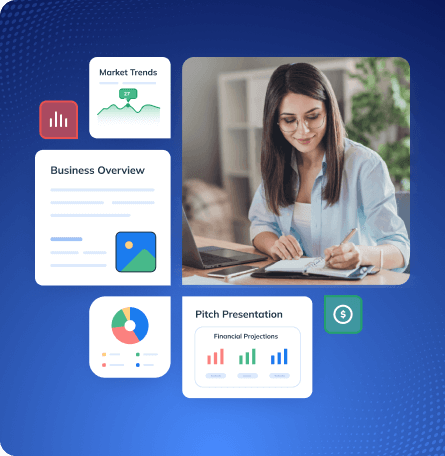You’ve got the vision—a clean, safe, fun indoor playground that parents trust and kids love. That sounds awesome!
But to turn that idea into a real business, you’ll need more than colorful play areas, birthday themes, and soft equipment. You require a solid plan that helps you map out what you’re offering, what it costs, and how you’ll make it all work.
Wondering how to draft a plan? Don’t worry!
This indoor playground business plan template makes it easy. Just follow the simple steps to get started with confidence.
What is an indoor playground business plan?
An indoor playground business plan is a professionally written document that clearly explains how your business will work. It covers what services you’ll provide, who your customers are, how you’ll operate, how you’ll make money, and what your goals are.
A good business plan keeps you focused, helps avoid surprises, and is essential if you need to apply for a loan or attract investors.
→ Download Now: Free Playground Business Plan
Key components included in an indoor playground business plan
Here’s a simple breakdown of the key elements of an indoor playground business plan:
Executive Summary:
Quick snapshot of your indoor playground—business goals, target market, and financial outlook.
Business Description:
What you’re building, your legal setup, business location, and what makes it special.
Industry and Market Analysis:
Insights into the indoor playground industry, your target market, customer needs, and competitor research.
Products and Services:
What you’ll offer—open play, birthday packages, memberships, events, and extras.
Marketing and Sales Strategy:
How you’ll bring in families and keep them coming—ads, local promotions, and loyalty offers.
Operations Plan:
Your daily setup: hours, staffing, equipment, safety steps, and how the place runs.
Management Team:
Who’s leading the business, what they bring to the table, and your hiring plans.
Financial Plan:
Start-up and monthly costs, expected revenue, funding needs, and break-even point.
Appendix:
Add-on materials like permits, layout plans, supplier quotes, or research data.
How to write a detailed indoor playground business plan?
A solid business plan helps you organize every aspect of your indoor playground, from setup and safety to pricing and funding. It also builds trust with investors, banks, and even landlords.
Here’s how to write each section of your plan, with everything you need to include:
1. Executive Summary
The executive summary gives a clear, brief snapshot of your entire indoor playground business plan. It should tell readers what your business is all about, who it’s for, and why it’s worth paying attention to.
- Introduce your business name, location, and the main services (like open play, parties, or memberships).
- Mention your target customers (e.g., local families, schools) and what makes your playground stand out. Jot down your marketing tactics as well.
- Summarize your future goals and include key financial projections such as your startup costs, funding needed, or revenue forecast.
Say goodbye to boring templates
Build your business plan faster and easier with AI
Plans starting from $14/month

2. Business Description
This section describes your playground idea in more detail, including what you offer, how your business is set up, and why it fits your area.
- Explain what kind of playground you’re opening. Drop-in play, memberships, birthday events, or a mix of all three?
- Mention your legal structure (LLC, sole proprietor, etc.), and include your playground’s location and its advantages. Share your mission statement and values.
- Discuss why you started the business and how it fills a need in the local market. Talk about your business’s short- and long-term goals.
3. Industry and Market Analysis
This section proves there’s demand for your business. You’ll need to back your idea with real data, local insights, and a close look at your competitors.
- Describe who your main customers are: Parents, schools, caregivers, or event planners. Mention their habits, income levels, and what they value most.
- Talk about local demand for safe indoor play and trends like birthday party spending or seasonal traffic. Support with credible stats if possible.
- List nearby competitors and what they offer. Explain how your services, space, pricing, or features are different or better.
4. Products and Services
Here, you outline exactly what your playground will offer, how each service is priced, and how these offerings bring in consistent revenue.
- List your core offerings like open play sessions, birthday parties, memberships, group bookings, as well as special events.
- Mention extras such as snack counters, sensory zones, workshops, or retail items. Explain what makes your offerings stand out, like themed events or age-specific areas.
- Describe pricing options, packages, or tiers (e.g., weekday vs. weekend rates).
5. Marketing and Sales Strategy
This section shows how you’ll bring in traffic (both online and in person) and how you’ll turn one-time visitors into regulars.
- List your main marketing channels: social media, Google Maps for visibility, school partnerships, community events, and word-of-mouth referrals.
- Share pricing plans that encourage repeat visits, like unlimited monthly passes, party discounts, weekday specials, and referral rewards.
- Describe your branding—logo, colors, tone, and messaging, and how you’ll present your playground across your website, signage, social media, and ads.
6. Operations Plan
Your operations plan explains how your playground works behind the scenes. It covers your daily routine, staff needs, tools, and how you’ll stay organized and safe.
- Outline your daily flow—opening and closing times, staff shifts, check-in process, peak hours, and how you’ll manage busy weekends or party bookings.
- List tools like online booking platforms, POS systems, waiver apps, and cleaning checklists to manage everything smoothly.
- Include how you’ll handle equipment checks, restocking snacks or supplies, and managing vendor orders or maintenance issues.
7. Management Team
Investors or lenders want to know that your business is led by people who can run it well. Use this section to show your team’s strengths and how roles are divided.
- Introduce the founders or key partners, and explain what experience they bring, such as childcare, business, safety, or customer service.
- List all roles you’ll need to fill: floor supervisors, party hosts, front desk staff, cleaners, and café helpers (if applicable).
- Explain your hiring plan, how you’ll train your team, and any systems in place for scheduling and performance checks.
8. Financial Plan
This section breaks down your costs, how you plan to make money, and what your financial goals are. It should feel realistic and well-researched.
- Share your startup budget—including equipment, renovations, licenses, software, branding, and your first few months of payroll and rent.
- Provide monthly revenue projections based on open play visitors, party bookings, memberships, and food or product sales. Compare it with ongoing expenses like rent, wages, and utilities.
- Include basic financial statements: a profit/loss projection, a simple cash flow plan, and your breakeven point. If asking for funding, explain how much you need.
9. Appendix
The appendix includes documents and visuals that support your plan. It gives your business more credibility.
- Attach layout sketches of your playground, mood boards, or branding samples to show the concept visually.
- Include real documents like permits, quotes from equipment vendors, lease agreements, or insurance details.
- Add supporting research: parent survey results, local competitor pricing, or booking data from early test events if available.
Key considerations for an indoor playground
Running an indoor playground means making smart choices before you open the doors. Keep the following key details in mind to avoid problems later:
- Playground format: Choose a setup that fits your business model—drop-in play, memberships, private events, or a mix. This affects pricing, layout, and staffing.
- Location: Select a space that’s easy for families to reach, near schools or neighborhoods with parking and safe access. Check zoning and ceiling height.
- Equipment & safety: Invest in soft, durable equipment built for frequent use and varied age groups. Follow safety standards and install proper padding and secure structures.
- Staffing: Hire friendly staff who handle kids, parties, and emergencies. Factor in training, background checks, and flexible shifts for weekends and holidays.
- Cleanliness & maintenance: Keep the space clean and well-maintained. Post cleaning routines and budget for regular checks and repairs.
- Customer comfort: Design your space with adults in mind, too. Add parent seating, snack options, stroller space, and toddler zones. Keep sightlines open for easy supervision.
- Seasonal planning: Expect busier weekends and holidays. Prepare with extra staff and promotional events. Use slow periods to offer discounts, school visits, or indoor classes.
Download an indoor playground business plan sample
Ready to write your indoor playground business plan? But not sure where to start? No worries! Download our free indoor playground business plan sample to get started with ease.
This modern, intuitive business plan template comes with pre-filled examples and simple formatting to save you time and get you going faster. You can even customize it to create your own plan that fits your business-specific requirements.
The Quickest Way to turn a Business Idea into a Business Plan
Fill-in-the-blanks and automatic financials make it easy.
Prepare your business plan in Upmetrics
After exploring this step-by-step guide and free template, you’re now well-prepared to draft your own indoor playground business plan.
However, if you’re feeling stuck or looking to write your plan faster and with less stress, try Upmetrics. It’s an AI-powered business planning tool that simplifies the entire process and lets you generate an actionable plan in just a few minutes.
So, why wait? Start planning using Upmetrics!



